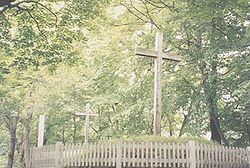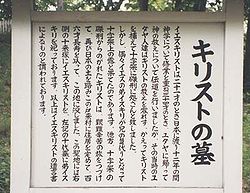
Shingo, Aomori
Encyclopedia


Villages of Japan
A is a local administrative unit in Japan.It is a local public body along with , , and . Geographically, a village's extent is contained within a prefecture....
located in the Sannohe District
Sannohe District, Aomori
is a district located in Aomori Prefecture, Japan. It occupies the southeast corner of the prefecture, bordering Iwate Prefecture.As of 2010, the district has an estimated population of 73,955 and a density of 76.3 persons per km². The total area was 969.38 km².- Towns and villages :The...
of south-central Aomori Prefecture
Aomori Prefecture
is a prefecture of Japan located in the Tōhoku Region. The capital is the city of Aomori.- History :Until the Meiji Restoration, the area of Aomori prefecture was known as Mutsu Province....
in the Tōhoku region
Tohoku region
The is a geographical area of Japan. The region occupies the northeastern portion of Honshu, the largest island of Japan. The region consists of six prefectures : Akita, Aomori, Fukushima, Iwate, Miyagi and Yamagata....
of Japan
Japan
Japan is an island nation in East Asia. Located in the Pacific Ocean, it lies to the east of the Sea of Japan, China, North Korea, South Korea and Russia, stretching from the Sea of Okhotsk in the north to the East China Sea and Taiwan in the south...
. As of 2009, the village had an estimated population
Population
A population is all the organisms that both belong to the same group or species and live in the same geographical area. The area that is used to define a sexual population is such that inter-breeding is possible between any pair within the area and more probable than cross-breeding with individuals...
of 2,830 and a density
Population density
Population density is a measurement of population per unit area or unit volume. It is frequently applied to living organisms, and particularly to humans...
of 18.8 persons per km². Its total area was 150.85 km². The village promotes itself as the home of the after a local legend.
Geography
Shingō is in south-central Aomori Prefecture, east of Lake TowadaLake Towada
is the largest crater lake in Honshū island, Japan. Located on the border between Aomori and Akita prefectures, it lies 400 meters above sea level and is 327.0m depth, and is drained by the Oirase river. With a surface area of 61.1 km², Towada is Japan's 12th largest lake, its bright blue...
. Much of the village is mountainous, rising to over 1000 meters in altitude near the border with Akita Prefecture
Akita Prefecture
is a prefecture of Japan located in the Tōhoku Region of northern Honshu, the main island of Japan. The capital is the city of Akita.- History :The area of Akita has been created from the ancient provinces of Dewa and Mutsu....
. The village has a cold maritime climate characterized by cool short summers and long cold winters with very heavy snowfall.
Neighbouring municipalities
Aomori PrefectureAomori Prefecture
is a prefecture of Japan located in the Tōhoku Region. The capital is the city of Aomori.- History :Until the Meiji Restoration, the area of Aomori prefecture was known as Mutsu Province....
- TowadaTowada, Aomoriis a city located in central Aomori in Tōhoku region of Japan. As of 2009, the city had an estimated population of 65,818 and a density of 90.7 persons per km². Its total area was 725.67 km², making it the largest municipality in Aomori Prefecture in terms of area.-Geography:Towada is located in...
- Sannohe DistrictSannohe District, Aomoriis a district located in Aomori Prefecture, Japan. It occupies the southeast corner of the prefecture, bordering Iwate Prefecture.As of 2010, the district has an estimated population of 73,955 and a density of 76.3 persons per km². The total area was 969.38 km².- Towns and villages :The...
- GonoheGonohe, Aomoriis a town located in Sannohe District, Aomori, Japan. Gonohe Town is located in the north-eastern part of Sannohe-gun, approximately 16 kilometres west of Hachinohe City and 10 kilometres southeast of Towada City. The town is adjacent to Hachinohe City to the east, Shingo Village to the west, Nanbu...
- NanbuNanbu, Aomoriis a town located in the Sannohe District of southeastern Aomori Prefecture in the Tōhoku region of Japan. As of 2009, the town had an estimated population of 20,381 and a density of 133 persons per km². Its total area was 153.150 km².-Geography:...
- SannoheSannohe, Aomoriis a town located in the Sannohe District of southeastern Aomori Prefecture in the Tōhoku region of Japan. As of 2009, the town had an estimated population of 11,426 and a density of 75.4 persons per km². Its total area was 151.55.91 km².-Geography:...
- Gonohe
Akita Prefecture
Akita Prefecture
is a prefecture of Japan located in the Tōhoku Region of northern Honshu, the main island of Japan. The capital is the city of Akita.- History :The area of Akita has been created from the ancient provinces of Dewa and Mutsu....
- KazunoKazuno, Akitais a city located in Akita, Japan.As of 2011, the city has an estimated population of 33,664 and the density of 47.6 persons per km². The total area is 707.34 km².The city was founded on April 1, 1972.-External links:...
History
The area around Shingō was controlled by the Nambu clan of Morioka DomainMorioka Domain
The was a han or feudal domain that encompasses present-day the middle-northern part of Iwate Prefecture and eastern part of Aomori Prefecture. It is sometimes colloquially called . The domain was tozama daimyo and was governed by the Satake clan. Its income was 100,000...
during the Edo period
Edo period
The , or , is a division of Japanese history which was ruled by the shoguns of the Tokugawa family, running from 1603 to 1868. The political entity of this period was the Tokugawa shogunate....
. During the cadastral reform of 1889, Herai Village and neighboring Nozawa Village were formed. On July 29, 1955 the western portion of Nozawa Village merged into Herai, which was then renamed Shingō.
Economy
The economy of Shingō is heavily dependent on agriculture. Notable crops include edible ChrysanthemumChrysanthemum
Chrysanthemums, often called mums or chrysanths, are of the genus constituting approximately 30 species of perennial flowering plants in the family Asteraceae which is native to Asia and northeastern Europe.-Etymology:...
, Japanese yam
Dioscorea
Dioscorea is a genus of over 600 species of flowering plants in the family Dioscoreaceae, native throughout the tropical and warm temperate regions of the world. The vast majority of the species are tropical, with only a few species extending into temperate climates...
and tobacco
Tobacco
Tobacco is an agricultural product processed from the leaves of plants in the genus Nicotiana. It can be consumed, used as a pesticide and, in the form of nicotine tartrate, used in some medicines...
. Traditionally a horse breeding area, Shingō is also known for its cattle ranches.
Tomb of Jesus Christ
Shingō village claims to be the last resting-place of JesusJesus
Jesus of Nazareth , commonly referred to as Jesus Christ or simply as Jesus or Christ, is the central figure of Christianity...
, buried in the "Tomb of Jesus." He did not die on the cross at Golgotha
Calvary
Calvary or Golgotha was the site, outside of ancient Jerusalem’s early first century walls, at which the crucifixion of Jesus is said to have occurred. Calvary and Golgotha are the English names for the site used in Western Christianity...
. Instead his brother, Isukiri, took his place on the cross, while Jesus fled across Siberia
Siberia
Siberia is an extensive region constituting almost all of Northern Asia. Comprising the central and eastern portion of the Russian Federation, it was part of the Soviet Union from its beginning, as its predecessor states, the Tsardom of Russia and the Russian Empire, conquered it during the 16th...
to Mutsu Province
Mutsu Province
was an old province of Japan in the area of Fukushima, Miyagi, Iwate and Aomori prefecture and the municipalities of Kazuno and Kosaka in Akita Prefecture...
, in northern Japan, where he became a rice farmer
Rice production in Japan
Rice production in Japan is important to the food supply in Japan, with rice being a staple part of the Japanese diet.The most striking feature of Japanese agriculture however is the shortage of farmland. The 4.63 million hectares under cultivation in 2008 has shrunk, with most farmers over...
, married, and raised a family near what is now Shingō. Entrepreneurs sell memorabilia and Jesus souvenirs to the tourists. Another tomb in Shingō is said to contain an ear of the brother of Jesus and a lock of hair from the Virgin Mary. The claims started in 1933 after the discovery of supposed "ancient Hebrew documents detailing Jesus' life and death in Japan" that was supposedly the testament of Jesus. These documents were allegedly seized by the Japanese authorities and taken to Tokyo
Tokyo
, ; officially , is one of the 47 prefectures of Japan. Tokyo is the capital of Japan, the center of the Greater Tokyo Area, and the largest metropolitan area of Japan. It is the seat of the Japanese government and the Imperial Palace, and the home of the Japanese Imperial Family...
shortly before World War II
World War II
World War II, or the Second World War , was a global conflict lasting from 1939 to 1945, involving most of the world's nations—including all of the great powers—eventually forming two opposing military alliances: the Allies and the Axis...
and have not been seen since.
The English text on the sign explaining the legend of the Tomb of Christ reads:
When Jesus Christ was 21 years old, he came to Japan and pursued knowledge of divinity for 12 years. He went back to Judea at age 33 and engaged in his mission. However, at that time, people in Judea would not accept Christ's preaching. Instead, they arrested him and tried to crucify him on a cross. His younger brother, Isukiri casually took Christ's place and ended his life on the cross.
Christ, who escaped the crucifixion, went through the ups and downs of travel, and again came to Japan. He settled right here in what is now called Herai Village, and died at the age of 106.
On this holy ground, there is dedicated a burial mound on the right to deify Christ, and a grave on the left to deify Isukiri.
The above description was given in a testament by Jesus Christ.

